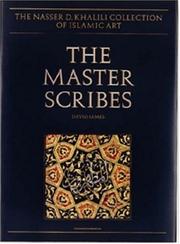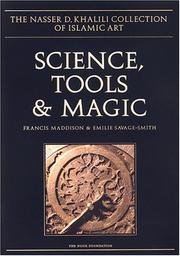| Listing 1 - 5 of 5 |
Sort by
|

ISBN: 1874780528 Year: 2005 Publisher: New York : MacMillan,
Abstract | Keywords | Export | Availability | Bookmark
 Loading...
Loading...Choose an application
- Reference Manager
- EndNote
- RefWorks (Direct export to RefWorks)
Islamic illumination of books and manuscripts --- Islamic calligraphy --- Enluminure islamique --- Calligraphie islamique --- Catalogs --- Catalogs. --- Catalogues --- Nasser D. Khalili Collection of Islamic Art --- Qurʼan --- Manuscripts --- Illustrations
Book
ISBN: 9781590203934 1590203933 Year: 2010 Publisher: New York : Overlook Press,
Abstract | Keywords | Export | Availability | Bookmark
 Loading...
Loading...Choose an application
- Reference Manager
- EndNote
- RefWorks (Direct export to RefWorks)
Islamic art --- Nasser D. Khalili Collection of Islamic Art --- Art collections

ISBN: 0197276105 9780197276105 Year: 1997 Volume: 12 Publisher: London: The Nour Foundation in association with Azimuth Editions and Oxford University Press,
Abstract | Keywords | Export | Availability | Bookmark
 Loading...
Loading...Choose an application
- Reference Manager
- EndNote
- RefWorks (Direct export to RefWorks)
Art, Islamic --- Islam and science --- Scientific apparatus and instruments --- Magic, Islamic --- Islamic antiquities --- Nasser D. Khalili Collection of Islamic Art --- Catalogs --- 297.33 --- Religion Islam Occultism --- Islamic art --- Islamic magic --- Muslim magic --- Art, Saracenic --- Muslim art --- Saracenic art --- Antiquities, Islamic --- Antiquities, Muslim --- Muslim antiquities --- Science and Islam --- Khalili Collection of Islamic Art --- Magic --- Art --- Antiquities --- Science --- Art, Islamic - Catalogs --- Scientific apparatus and instruments - Catalogs --- Islamic antiquities - Catalogs
Book

ISBN: 9781874780816 9781874780809 1874780803 Year: 2022 Publisher: London : The Nour Foundation : In association with Azimuth Editions,
Abstract | Keywords | Export | Availability | Bookmark
 Loading...
Loading...Choose an application
- Reference Manager
- EndNote
- RefWorks (Direct export to RefWorks)
Vol. 1 : This volume is devoted to the Collection's illustrated manuscripts and detached folios of the early 14th to the 18th centuries produced in Iran - religious, historical and heroic epic. Many images are of major artistic importance and come from texts of equal importance. Vol. 2 : This volume, which is in two parts, is mainly devoted to the Collection’s illustrated manuscripts and detached folios with painted illustrations – primarily romantic poetry and anthologies – and single page compositions – mostly portraiture and genre painting – from Iran and Turkey, dating from the 14th to the mid-19th centuries. Many items are of major artistic importance.Illustrated Persian manuscripts include several copies of the Khamsah of Nizami and a Divan of Hafiz dated AH 975 (AD 1567–8) with superbly illuminated margins and two exquisite paintings, one by Muhammadi and the other by ‘Abdallah al-Mudhahhib al-Shirazi.The large group of detached folios from Iran includes several of the late 15th century in the style of Muhammad Siyah Qalam (otherwise best represented in albums in the Topkapı Palace Library). Particularly strong in drawings from 17th-century Isfahan, it includes works by its most famous painters, Riza-yi ‘Abbasi, Muhammad Qasim, Mu‘in Musavvir, and the eclectic artists Muhammad Zaman, ‘Ali Quli Jubbah-dar and Shaykh ‘Abbasi.Ottoman paintings include two folios from the Siyer-i Nebi (‘Life of the Prophet’) made for Sultan Murad III, and an exquisite 16th-century drawing of a dragon in foliage in the style of Süleyman the Magnificent’s court painter, Shah Quli.
Enluminure arabe --- Enluminure arabe --- Miniature (peinture) --- Art islamique --- Illumination of books and manuscripts, Arab --- Illumination of books and manuscripts, Arab --- Painting, Iranian. --- Painting, Turkish. --- Islamic art --- Khalili, Nasser D. --- Art collections --- Catalogs. --- The Nasser D. Khalili Collection of Islamic Art (Londres, Angleterre).
Book

ISBN: 9781874780861 1874780862 9781874780861 1874780862 Year: 2013 Publisher: London : Oakville, CT : The Nour Foundation : in association with Azimuth Editions, Distributed in North America by The David Brown Book Company,
Abstract | Keywords | Export | Availability | Bookmark
 Loading...
Loading...Choose an application
- Reference Manager
- EndNote
- RefWorks (Direct export to RefWorks)
The Collection provides an unrivalled resource for the study of Islamic jewellery, with nearly 600 catalogued pieces in gold, silver and copper alloys, of all periods from the 7th to the 20th centuries and from throughout the Islamic world Spain to Malaysia, and Africa to the Eurasian steppes. Various sectors of production and clienteles are represented, from the court to bespoke jewellery to the urban marketplace. The jewellery also illustrates a correspondingly wide range of techniques and materials, including all the main methods of working gold, silver and copper alloys and their decoration especially filigree, niello, enamel and the setting of gems. Inevitably some periods, areas and techniques are better represented than others, but overall the Collection is remarkably comprehensive and in some areas, such as the Fatimid filigree, is among the finest in the world.^ This two-part volume includes virtually every form of personal adornment head, hair and headdress ornaments; earrings; nose rings; finger rings; pendants; beads; necklaces; bracelets, armlets and anklets; armband elements; amulets and amulet cases; pins and brooches; buttons; belts and belt fittings as well as harness fittings. Separate volumes in the Nasser D. Khalili Collection of Islamic Art series have been devoted to rings (vol. XVI) and the jewellery from Mughal India (vol. XVIII); more of the belt and harness fittings were included in the study of arms and armour (vol. XXI).^ Outstanding among the Khalili Collection jewellery are the Fatimid pieces, which include a pair of gold pins with extraordinarily fine vegetal designs rendered in the characteristic rope-and-grain filigree of Egypt or Syria; the many bracelets of the 10th early 13th centuries, including exceptional ones of gold sheet set with gems and decorated with inlaid niello and granulation made in Iran; the gold and silver repousse huntsmen s belt fittings from the Golden Horde Central Asia or the Qipchaq steppe, with clear Khitan or Jin influence; a larger number of enamelled and gilded copper-alloy belt and harness fittings from Nasrid Spain than in most other collections; an exquisite two-headed eagle in gold filigree set with emeralds from 18th-century Morocco; and a large group of Iranian enamelled jewellery of the Qajar period, including excellent enamelled pendants with portraits of the Qajar Shahs.^ In addition to Michael Spink s expertise in Islamic art and jewellery across its full geographical range brought to bear throughout the catalogue, Jack Ogden s comprehensive knowledge of ancient jewellery and jewellery technology is reflected in two important surveys of techniques and materials. Mark G. Kramarovksy contributed an important discussion of the origins of the spiral filigree style. Pedro Moura Carvalho reviewed the evidence for enamelling in Iran under the Safavid and Zand dynasties. J.M. Rogers made numerous additions, most notably his survey of the documentation of Ottoman jewellery, and with Manijeh Bayani have made the text of Nishaburi on medieval enamelling accessible to a wider audience.
Islamic jewelry. --- Islamic jewelry --- History.
| Listing 1 - 5 of 5 |
Sort by
|

 Search
Search Feedback
Feedback About UniCat
About UniCat  Help
Help News
News